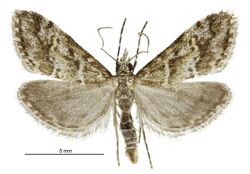Biology:Culladia strophaea
| Culladia strophaea | |
|---|---|

| |
| male | |

| |
| female | |
| Scientific classification | |
| Domain: | Eukaryota |
| Kingdom: | Animalia |
| Phylum: | Arthropoda |
| Class: | Insecta |
| Order: | Lepidoptera |
| Family: | Crambidae |
| Genus: | Culladia |
| Species: | C. strophaea
|
| Binomial name | |
| Culladia strophaea (Meyrick, 1905)
| |
| Synonyms | |
| |
Culladia strophaea is a species of moth in the family Crambidae.[1] It is endemic to New Zealand.[1][2] The taxonomy of this species is currently uncertain.
Taxonomy
This species was first described by Edward Meyrick in 1905 as Argyria strophaea using specimens collected in Wellington by George Hudson.[3][4] Hudson discussed and illustrated the species under this name in his 1928 book The Butterflies and Moths of New Zealand.[5] The lectotype of this species is held at the Natural History Museum, London.[4]
In 1973 D. E. Gaskin placed A. strophaea within the genus Culladia.[6] This placement is currently under debate and is regarded by some scientists as erroneous.[7] As a result, this species is also referred to as Argyria (s.l.) strophaea or alternatively by its original name despite the later also being regarded as erroneous.[8][9]
Description
Meyrick described this species as follows:
♂︎♀︎. 15-18 mm. Head and thorax ochreous-whitish, partially yellowish-tinged, and sprinkled with dark grey. Palpi 4, grey, darker-sprinkled, whitish above and towards base beneath. Antennae ochreous-whitish, obscurely ringed with dark fuscous. Abdomen ochreous-whitish irrorated with dark grey. Fore-wings elongate-triangular, costa gently arched, apex obtuse, termen slightly rounded, oblique, faintly waved ; pale brassy-ochreous, suffusedly mixed with white, and irrorated with dark grey ; subbasal line white, edged anteriorly with dark fuscous, angulated near costa, obsolete towards dorsum ; first and second lines white, more or less edged with dark fuscous, first obtusely angulated above middle, second sinuate inwards towards dorsum, preceded on costa by a small dark fuscous spot ; a small roundish dark fuscous spot in disc before middle ; a narrow white transverse mark in disc beyond middle; a terminal series of dark fuscous lunulate marks: cilia whitish, with a fuscous subapical Hue, basal half barred with fuscous. Hind-wings grey, darker posteriorly ; cilia as in fore-wings.[3]
Distribution
This species is endemic to New Zealand.[1][8] This species can be found in the North Island as well as in the provinces of Nelson and Westland in the South Island.[6] Other than the type locality of Wellington, this species has also been found at Whakarewarewa, Raurimu, Whanganui,[5] Haruru falls in the Bay of Islands, Lake Taupō, Bluff Hill in Napier, and at Lake Rotorua.[6]
Biology and behaviour
Larvae of this species have been found in soil.[10] This species is on the wing in January.[5] Specimens of this species have been collected with mercury vapour light traps and 15watt UV light traps.[11][10] Alfred Philpott studied the male genitalia of this species in 1929.[12]
Host species and habitat
It frequents stony cuttings, often by roadsides, near forest habitat.[5]
References
- ↑ 1.0 1.1 1.2 "Culladia strophaea Meyrick, 1905". Landcare Research New Zealand Ltd. http://www.nzor.org.nz/names/710c0db1-640b-4f06-a36b-76b6c171d12f.
- ↑ "GlobIZ search". http://globiz.pyraloidea.org/Pages/Reports/TaxonReport.aspx.
- ↑ 3.0 3.1 Meyrick, Edward (1905). "Notes on New Zealand Lepidoptera." (in en). Transactions of the Entomological Society of London 1905 (2): 219–244. doi:10.1111/j.1365-2311.1905.tb02451.x. https://biodiversitylibrary.org/page/14788046.
- ↑ 4.0 4.1 Dugdale, J. S. (1988). "Lepidoptera - annotated catalogue, and keys to family-group taxa". Fauna of New Zealand 14: 1–262. https://www.landcareresearch.co.nz/__data/assets/pdf_file/0003/49008/FNZ14Dugdale1988150.pdf. Retrieved 2017-10-16.
- ↑ 5.0 5.1 5.2 5.3 Hudson, G. V. (1928). The Butterflies and Moths of New Zealand. Wellington: Ferguson & Osborn Ltd.. pp. 170. OCLC 25449322. http://www.bugz.org.nz/WebForms/ResultDetails.aspx?CurrentDoc=C7E94865-492F-45DA-9777-CC8E1E8B1438&back=true&NewDoc=true&searchType=1&SearchString=G.V.+Hudson.
- ↑ 6.0 6.1 6.2 Gaskin, D.E. (1973). "Revision of New Zealand Chilonini (Lepidoptera: Pyralidae) and redescription of some Australian species". New Zealand Journal of Science 16: 435–463. http://www.bugz.org.nz/WebForms/ResultDetails.aspx?CurrentDoc=4B0838CD-4353-4B9C-853C-72C974EB5478&back=true&NewDoc=true&searchType=1&SearchString=Gaskin.
- ↑ Hoare, Robert J. B. (2001-12-01). "Adventive species of Lepidoptera recorded for the first time in New Zealand since 1988". New Zealand Entomologist 24 (1): 23–47. doi:10.1080/00779962.2001.9722079. ISSN 0077-9962.
- ↑ 8.0 8.1 , p. 458, Wikidata Q45922947
- ↑ "Introduction to Pyraloidea families and subfamilies of New Zealand" (in en). Landcare Research New Zealand Ltd. https://www.landcareresearch.co.nz/resources/identification/animals/large-moths/image-gallery/pyraloid-moths/pyraloidea-introduction.
- ↑ 10.0 10.1 K., Curtis; H., Bowie, Michael; S., Barber, Keith; Stephane, Boyer; M., Marris, John W.; B., Patrick (2016) (in en). Assessing the invertebrate fauna trajectories in remediation sites of Winstone Aggregates Hunua quarry in Auckland. Christchurch: Lincoln University. p. 46. ISBN 978-0-86476-417-1.
- ↑ Bennik, Rebecca Marie (2014). "Sexual conflict and genital evolution in moths". https://researchspace.auckland.ac.nz/bitstream/handle/2292/24100/whole.pdf?sequence=2.
- ↑ Philpott, A. (1929). "The Male Genitalia of the New Zealand Crambidae.". Transactions and Proceedings of the New Zealand Institute 60: 497. http://rsnz.natlib.govt.nz/volume/rsnz_60/rsnz_60_03_006910.html. Retrieved 12 June 2018.
Wikidata ☰ Q13504942 entry
 |

